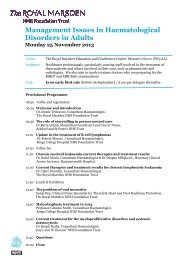8-cyberknife-trials - Royal Marsden Hospital
8-cyberknife-trials - Royal Marsden Hospital
8-cyberknife-trials - Royal Marsden Hospital
Create successful ePaper yourself
Turn your PDF publications into a flip-book with our unique Google optimized e-Paper software.
The <strong>Royal</strong> <strong>Marsden</strong>Presentation today– Cyberknife introduction– Proposed trial for oligometastases– Other <strong>trials</strong> we are hoping to run
The <strong>Royal</strong> <strong>Marsden</strong>
The <strong>Royal</strong> <strong>Marsden</strong>How do we usually deliver radiotherapy?– 2-4 beams
The <strong>Royal</strong> <strong>Marsden</strong>What is the problem?– A large amount of normal tissue gets a high dose ofradiotherapy (unwanted)
The <strong>Royal</strong> <strong>Marsden</strong>How do we usually deliver radiotherapy?– Line up to skin tattoos
The <strong>Royal</strong> <strong>Marsden</strong>What is the problem?– Tumours ( and normal organs around them) moveduring radiotherapy and from day to day.
The <strong>Royal</strong> <strong>Marsden</strong>What is Cyberknife?– Radiotherapy – no knives!– Normal radiotherapy machine but mounted on arobot– Delivers very small amounts of radiotherapy frommany different directions– Moves with the tumour
The <strong>Royal</strong> <strong>Marsden</strong>X-ray SourcesIMAGINGSYSTEMLinearAcceleratorROBOTICDELIVERYSYSTEMTARGETING SOFTWAREIRISManipulatorImageDetectors
The <strong>Royal</strong> <strong>Marsden</strong>
The <strong>Royal</strong> <strong>Marsden</strong>How does Cyberknife track the tumour?– Skull tracking – uses the bony contour of the skull toadjust for small movements– Used for tumours inside the head
The <strong>Royal</strong> <strong>Marsden</strong>How does Cyberknife track the tumour? – spinetracking
The <strong>Royal</strong> <strong>Marsden</strong>How does Cyberknife track the tumour? – fiducialtracking
The <strong>Royal</strong> <strong>Marsden</strong>How does Cyberknife track the tumour? - lung
The <strong>Royal</strong> <strong>Marsden</strong>What about breathing? - Synchrony
The <strong>Royal</strong> <strong>Marsden</strong>What else is different about Cyberknife?– Fewer treatments ( 1-5 fractions)– E.g. conventional prostate radiotherapy:Normal radiotherapy 37 daily treatmentsCyberknife 5 treatments– Can deliver “radioablative doses” – destroy all tissuethat is targetted
The <strong>Royal</strong> <strong>Marsden</strong>
The <strong>Royal</strong> <strong>Marsden</strong>Sounds too good to be true?– Treatment times much longer 35 mins – 2 hours forcomplicated synchrony cases– Lack of long term efficacy data, despite use in theUSA for >8 years
The <strong>Royal</strong> <strong>Marsden</strong>Oligometastasis trial– Before cancer metastasizes (spreads) we know we cancure– After cancer metastasizes, we aim to control cancerbut cannot usually cure– Is there a subset of patients where the cancer has onlyspread to 1-2 areas, where we still have theopportunity to cure?
The <strong>Royal</strong> <strong>Marsden</strong>What do we know already?– Liver metastases from colorectal cancer – long termsurvivors after resection– Lymph node metastases from breast cancer – stillpotentially curable– Lung metastases from sarcoma
The <strong>Royal</strong> <strong>Marsden</strong>Oligometastases trial– 50 patients initially for a pilot study– Variety of tumour types– 1-3 sites of metastases– No other treatment that we know will cure
The <strong>Royal</strong> <strong>Marsden</strong>Trial designPatients with1-3 metastasesRandomise15 Gy in 3 fractions 45 Gy in 3 fractions
The <strong>Royal</strong> <strong>Marsden</strong>Outcomes– Initial pilot study will establish feasibility of this trialdesign in 50 patients- will they accept randomisation?– How do they tolerate the treatment?– What parameters should be stipulated if this proceedsto a larger multicentre trial? Eg maximum size ofmetastasis, do some sites do worse?
The <strong>Royal</strong> <strong>Marsden</strong>Ultimate aim– Larger trial, incorporating all UK NHS Cyberknifecentres (currently 3) to look at cause-specificsurvival– i.e. do less patients die of their cancer after high doseCyberknife radiotherapy?– Potentially could extend to other types of focussed(stereotactic) radiotherapy on machines other thanCyberknife
The <strong>Royal</strong> <strong>Marsden</strong>Questions for you– One other proposal is to randomise betweenCyberknife high dose radiotherapy and Noradiotherapy at all (as these patients would notusually get any radiotherapy) – do you think patientswould accept this?
The <strong>Royal</strong> <strong>Marsden</strong>Trial design?Patients with1-3 metastasesRandomiseStandard of carei.e no treatment45 Gy in 3 fractions
The <strong>Royal</strong> <strong>Marsden</strong>Other <strong>trials</strong>– Low/Intermediate risk prostate cancer: randomisingto surgery/Cyberknife and Cyberknife/conventionalradiotherapy– Prostate boost study – looking at just concentratingradiotherapy on the area of tumour rather than thewhole gland– Liver metastases from colorectal cancer: treating with45 Gy in 3 fractions
The <strong>Royal</strong> <strong>Marsden</strong>A note of caution– New technology brings new possibilities both tosucceed and to fail.
















